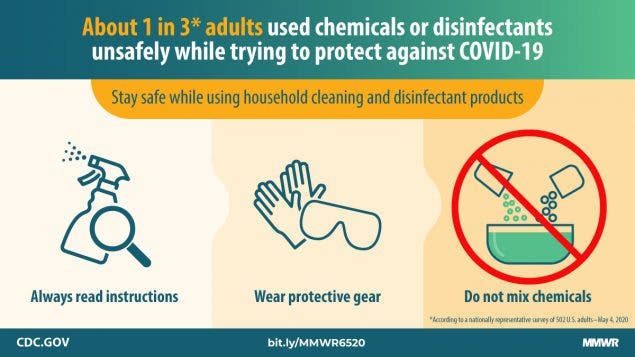A shocking proportion of the American public are using disinfectants improperly, jeopardizing their health and that of their families. According to a recent survey performed by CDC researchers, about one-third of the respondents engaged in high-risk practices by misusing disinfectants.

In April, records from the National Poison Data System suggested that US poison centers reported a 20% surge in calls from January to April compared to the same period in the previous year.
For instance, one case involved a woman who filled her sink with bleach, vinegar, and water. She meant to use this concoction to disinfect produce she had just bought from the supermarket in order to minimize the risk of becoming infected with the coronavirus. The problem is that the mixture of substances chemically reacted and released toxic chlorine gas, causing the woman to experience trouble breathing and a heavy cough. She recovered days later after receiving oxygen therapy at the hospital, but her case is by no means singular.
According to a new survey performed by CDC researchers involving a nationally-representative sample of 502 adults who responded on May 4, a worrisome proportion of Americans are misusing cleaning products.
Around 39% of U.S. adults engaged in high-risk practices with the intent of preventing the transmission of the coronavirus. These include washing food products with bleach, applying household cleaning or disinfectant products to bare skin, and intentionally inhaling or ingesting these products.
Specifically, 19% applied bleach to food items such as fruits and vegetables at least once, 18% applied household cleaning and disinfectant products directly onto the hands or skin, 10% misted the body with a cleaning or disinfectant spray, 6% intentionally inhaled vapors from cleaning products or disinfectants, and 4% drank or gargled diluted bleach solutions, soapy water, and other cleaning products.
Although the survey did not offer explanations for these behaviors, there are good reasons to believe that it is owed to a dangerous combination of fear due to the pandemic and poor knowledge on how to properly handle cleaning products and disinfectants.
For instance, the survey found that only 23% of the respondents were aware that only room temperature water should be used when preparing a dilute bleach solution. The survey also reported that just 35% of the respondents knew that they should never mix bleach with vinegar and 58% were aware not to mix bleach with ammonia.
But, as another confirmation of the Dunning-Kruger effect, more than half of the respondents (51%) strongly agreed that they knew how to clean and disinfect their home safely.
“Mixing of bleach solutions with vinegar or ammonia, as well as application of heat, can generate chlorine and chloramine gases that might result in severe lung tissue damage when inhaled. Furthermore, exposures of children to hand sanitizers, particularly via ingestion, can be associated with irritation of mucous membranes, gastrointestinal effects, and in severe cases, alcohol toxicity. The risk of ingestion and consequent toxicity from improperly stored hand sanitizers, cleaners, and disinfectants can also extend to pets,” the authors of the new CDC report wrote.
Due to poor handling of bleach and other cleaning products, 25% of the respondents reported at least one adverse health effect during the previous month, including nose, skin, and eye irritation, dizziness, lightheadedness, or headache, nausea, and breathing problems.
Out of all the high-risk misuses of cleaning products, purposefully ingesting or inhaling such products is certainly the most dangerous. And while washing and spraying food packaging with disinfectant has been recommended, people should always be careful that the food itself never gets soaked. Obviously, you should never wash vegetables, fruits, and other foodstuffs directly with bleach or other disinfectants. Instead, rinsing fresh fruits and vegetables with clean water should be sufficient.






